We’re now bringing down the curtain on this blog. Read the latest story on today’s winners here. Tomorrow it’s the Nobel Prize for Physics – join us again.
Nobel prize in medicine goes to pioneers in parasitic diseases – as it happened
The first of three prestigious science prizes on the first day of Nobel week are revealed: William Campbell and Satoshi Omura for their work on a therapy against roundworm, shared with Youyou Tu, for a therapy against malaria
Mon 5 Oct 2015 07.02 EDT
First published on Mon 5 Oct 2015 04.35 EDT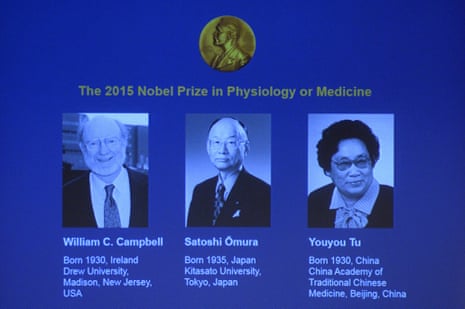
Live feed

Sarah Bosely has some details on avermectins, the drugs combating some parasites developed by Campbell and Ōmura.
The avermectins are a group of naturally occurring compounds, which have strong insecticidal and anti-worm properties. One of the family, ivermectin, was a breakthrough discovery in 1987 in the treatment of river blindness (onchocerciasis), one of the neglected tropical diseases that wreck the lives of many millions of poor people in the developing world and are rarely a goal for drug developers because there is no market in wealthy countries.
The earlier drugs for river blindness had serious side-effects and were not as effective as ivermectin, which kills the larval Onchocerca volvulus worms – microfilariae – that live in the subcutaneous tissue of an infected person.
It does not kill the adult worms so it has to be repeated once a year for up to 18 years to cure somebody. It is an oral pill, so easy to take, however, and the manufacturer, Merck, has promised to donate the tablets for free for as long as necessary to eliminate the disease.
The disease causes intense itching, skin discolouration, rashes, and eye disease, which often leads to blindness. It is spread by infected black flies which breed in rivers.
The World Health Organisation says the drug has “transformed the lives of millions of people suffering from onchocerciasis” since 1987.
My colleague Ian Sample has now written this longer version of our story on today’s announcement.
Here’s an interview with Omura by the Nobel Prize website people. “I humbly accept and I’m very surprised,” he says.
EXCLUSIVE Interview with Satoshi Ōmura on golf, great scientists, and the 2015 #NobelPrize in Physiology or Medicine https://t.co/Ia8tNPliNK
— The Nobel Prize (@NobelPrize) October 5, 2015
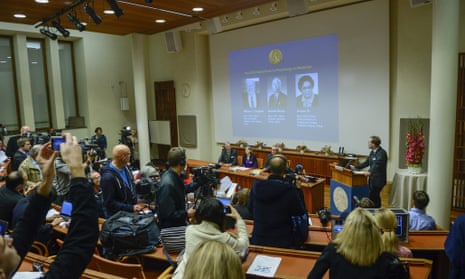

My colleague Sarah Boseley has sent this background on Artemisinin, the anti-malaria drug developed by Tu.
Artemisinin is now the mainstay of malaria treatment in Africa – a drug that has helped turn around the epidemic.
Malaria parasites have developed resistance to every drug that has been thrown at them, beginning with quinine. Chloroquine and later sulfadoxine-pyrimethanine, which were the mainstays of treatment through the latter part of the 19th century, were no longer reliable by the early part of this century and new drugs were desperately needed.
Artemisinin was a new drug and yet an old drug – a plant that was a staple of traditional Chinese medicine. It has transformed malaria treatment. The decline in malaria deaths in Africa and Asia is attributed to the drug in conjunction with the widespread use of insecticide-impregnated bednets, two of the tools without which the global eradication campaign would be struggling.
Between 2000 and 2013, malaria mortality rates decreased by an estimated 47% worldwide and by 54% in Africa. Among babies and children under five, the main target group. death rates have declined by 53% globally, and by 58% in Africa, although the disease still killed 453,000 in 2013.
Wary of the real dangers of resistance, there has been a huge effort to ensure artemisinin is not used alone, but in combination with other drugs. Even so, there are reports of resistance developing in south-east Asia.
We’re told Tu Youyou might be in the US at the moment. Here’s a photo of her, just in case you’re there too, happen to spot her and want to pass on the good news. You never know.

Nobel have tweeted this mini-interview with Juleen Zierath, the Swedish-American biologist who chairs the Nobel committee for medicine.
Happy it was a surprise - Chair Nobel Committee @JuleenRZierath #NobelPrize http://t.co/zLaPpFkRTW
— The Nobel Prize (@NobelPrize) October 5, 2015
And as-yet unnamed member of the Nobel committee is about to give an interview, which you can watch live via this link, if you want.
Stay tuned – live streaming of interview with Nobel Committee member for Medicine coming up https://t.co/HHbVGAdwSi #NobelPrize 2015
— The Nobel Prize (@NobelPrize) October 5, 2015
Here’s our initial report on today’s announcement.
One questioner asks if Tu’s prize is, in effect, an award for traditional Chinese medicine. The response from the Nobel committee is a definite no: it awards her medical research for a drug which was “inspired” by traditional Chinese medicine.
The press conference and awards event is now over.
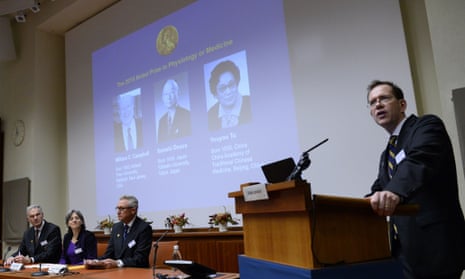
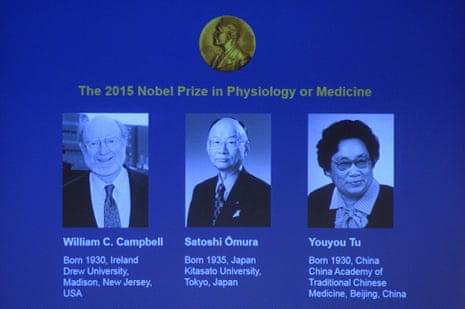




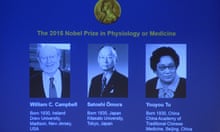

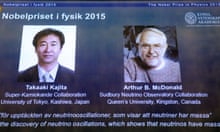
Comments (…)
Sign in or create your Guardian account to join the discussion